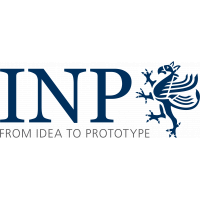Atmospheric pressure plasma source for the treatment of human or animal skin areas (e.g. chronic wounds) on the basis of a textile, flexible configuration

Fig 1 [L] Control unit with >100cm² textile patch and spacer [M] textile patch and space with cable [R] special patch design (active)
Field of application of the technology, potential partners
Veterinary and human medicine, wound dressing manufacturers
Description of the technology
The technology is a special design of a plasma source based on a dielectrically impeded discharge. This plasma source is designed in such a way that a flexible textile carrier material is used as the basis. A conductive textile layer is applied to its surface, which serves as the grounded electrode of the plasma configuration. This can be either woven or fleece material. The high-voltage electrode in the form of wire material (preferably polyimide) with special insulation is applied to this conductive layer. This electrode can be designed in any size and shape. In addition, geometries can be designed in the plasma configuration that contain special recesses in order to be able to wrap the plasma configuration around the geometry.
The connection to a high-voltage supply is made via a special plug/cable connection. The supply unit can be designed to be small (<<10 kV) and with low power requirements based on this technology and the voltages required. An embodiment based on battery technology is therefore possible.
Advantages of the technology
Due to the envisaged manufacturing technology, scaling and different designs (e.g. for the treatment of percutaneous accesses) are easier to implement than with other flexible plasma sources.
Assessment of the market potential
This technology can cover a huge market in the treatment of chronic wounds and burns in veterinary and human medicine.
Various types of wound dressings are currently in the development or prototype stage.
Relatively few products are ready for the market, not least due to the challenges posed by the approval systems in Europe and the USA.
The CPT®patch of Coldplasmatech GmbH and the PlasmaDerm®Dress of Cinogy GmbH are currently on the market. These products have a silicone base and therefore have to be poured into a mold during production. This material makes the production of different designs more difficult to implement than with the technology offered.
We are looking for
- Industrial Partner for further development of the technology
- Licensee
- Patent buyer.
